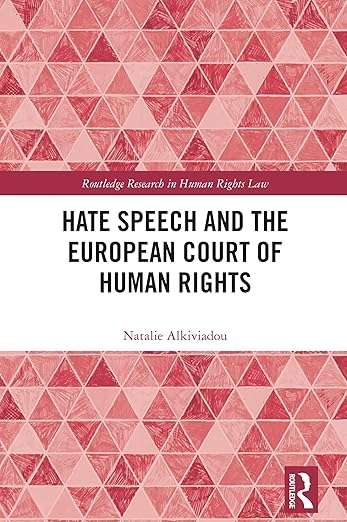
This book demonstrates that, with few exceptions, the ECtHR’s general approach to hate speech has been overly expansive, often undervaluing both the significance of free speech and the harms resulting from the suppression of relatively low-threshold expressions. While this book does not advocate for an entire revision of the European approach to hate speech as that would anyhow be unrealistic, it does argue for a more rigorously substantiated balancing exercise and a renewed adherence to the Handyside principle. In Handyside v The United Kingdom (1976), the ECtHR found that the right to freedom of expression as provided by Article 10 of the European Convention on Human Rights (ECHR) extends to ideas that may ‘offend, shock or disturb.’ The hate speech jurisprudence of the ECtHR, although ostensibly committed to the protection of the right to freedom of expression continues to suffer from a lack of conceptual clarity, inconsistencies in application and a limited engagement with relevant scholarly literature. Some key examples are put forth hereinafter.
Féret v Belgium (2009) is emblematic of the departure from Handyside principles as it embedded a paradigm which I refer to as the low threshold hatred paradigm. Féret involved an application by a far-right politician who distributed leaflets during an electoral campaign with statements such as “Stop the Islamization of Belgium” and allegations that a refugee centre “poisons the lives of residents.” In upholding domestic restrictions on such speech, the ECtHR equated insult, defamation and ridicule with hate speech that falls outside the protection of Article 10 of the European Convention on Human Rights (ECHR), denoting that incitement to violence is not a necessary pre-requisite for hate speech. Féret set a threshold precedent that would influence subsequent jurisprudence in which the ECtHR has systematically held that insults and/or defamation and/or prejudice and/or ridicule are enough to result in an Article 10 violation, even if they do not incite violence or other criminal acts.
Furthermore, rooted in the post-war consensus to combat anti-Semitism and Nazi propaganda, is the categorical exclusion of Holocaust denial from Convention protection through Article 17 of the ECHR, namely the prohibition of abuse of rights clause. This stems from the ECtHR’s recognition of the enduring harm caused by the Holocaust and its denial not only to survivors, their descendants and groups but also to European democratic values.
Indicatively, the ECtHR’s strict stance in relation to the Holocaust and its denial was put forth in Lehideux and Isorni v France (1998), in which the ECtHR ruled that there exists a “category of clearly established historical facts—such as the Holocaust —whose negation or revision would be removed from the protection of Article 10 by Article 17.” The ECtHR’s approach to genocides and genocide denial becomes less consistent when addressing denial of genocides other than the Holocaust. In Perinçek v Switzerland (2015), the ECtHR faced the question of whether denial of the Armenian genocide warranted criminal sanctions akin to Holocaust denial. Perinçek, a Turkish politician, publicly denied the Armenian genocide during events in Switzerland, describing it as an “international lie.” The ECtHR found that Perinçek had not committed an abuse of his rights within the meaning of Article 17 of the Convention, as is seen in Holocaust denial cases. As a result, the applicant was assessed under Article 10.
While the case resulted in a finding of no violation, the fact remains that the case in question did not meet the severity required under Article 17, while Holocaust denial is systematically categorised as inherently harmful and abusive under Article 17, regardless of whether Article 10 is integrated in its analysis. Its use of historical consensus as a criterion for addressing cases of genocide denial risks reinforcing state-endorsed narratives while silencing alternative viewpoints. This approach raises concerns about the ECtHR’s capacity to function as an impartial guardian of human rights. Furthermore, its divergent treatment of the Holocaust and the Armenian genocide points to an emergence of a hierarchy in the recognition of genocides and historical memory, thereby challenging the universal application of Convention safeguards in the Council of Europe region.
The ECtHR has taken varied approaches to speech related to totalitarian ideologies, applying a strict, exclusionary stance to Nazi glorification while adopting a more contextual, harm-based analysis for other symbols, particularly those tied to Communism or country-specific fascism. This is seen through the comparative spectrum of Vajnai v Hungary (2008) (red star), Fáber v Hungary (2012) (flag linked to the Arrow Cross Party) and Nix v Germany (2018) (Nazi symbols used on a public interest blog discussing racism in German government offices. This lack of uniform, principle-based reasoning across cases weakens legal predictability and the equitable application of free speech protections.
To complicate matters further, the rapidly evolving digital climate complicates the hate speech discussion predominantly due to the rise of private content moderation and regulatory outsourcing. The ECtHR’s tolerance of vague restrictions has influenced and been influenced by digital regulation across Europe. Platforms now act as de facto speech regulators, often erring on the side of over-removal to avoid liability. The ECtHR has reinforced this model. In Delfi AS v Estonia (2015), it upheld the liability of a news portal for user-generated hate comments. In Sanchez v France (2023), it approved the criminal conviction of a politician for failing to delete hateful third-party comments on his Facebook page. As I argue “with these two cases, ‘hate speech by proxy’ is born, with liability imposed even on those not uttering the hate speech.” Nevertheless, the ECtHR has yet to grapple with the full implications of this shift for free expression, particularly given the enormous power of online platforms in shaping public discourse.
In light of the above, the book argues that the ECtHR must recalibrate its approach to hate speech jurisprudence. This, in turn, must be grounded in a principled framework that reconciles the right to freedom of expression with the legitimate aim of combatting hate speech, which necessarily entails establishing a high threshold of harm. It must also take into account the implications of the rising digital agora of ideas, with its decisions, to date, being problematic. At present, the ECtHR often relies on expansive interpretations that categorise certain forms of expression as hate speech simply because they are offensive or insulting, without adequately demonstrating concrete societal harm.
Turning to International Human Rights Law and particularly Article 20(2) of the International Covenant on Civil and Political Rights as elaborated upon in the Rabat Plan of Action could be a starting point through which the ECtHR could reduce legal ambiguity and prevent the risk of excessive restriction. A solid extrapolation of what hate speech is and what harm the ECtHR attaches to it would ensure that only the most harmful forms of speech fall outside the protection of Article 10.
Accordingly, the ECtHR must be able to identify thresholds for prohibited speech, grounded in a sound and consistent definition. This must go beyond the binary ‘grave’ and ‘less grave’ distinction seen in Lilliendahl v Iceland (2020) and instead support a more nuanced model that protects expression while regulating genuinely harmful content. Such an approach would bring clarity and consistency to the ECtHR’s jurisprudence, a critical requirement for both individuals seeking protection under the Convention and for Contracting States.
Furthermore, to justify restrictions, the ECtHR must employ a consistent and evidence-based definition, while also drawing from scholarly research to inform its analyses. As the book demonstrates, the ECtHR frequently invokes vague assertions regarding the societal harm of impugned speech without sufficiently substantiating its claims. For example, in Vejdeland and Others v Sweden (2012), the ECtHR upheld restrictions on the distribution of homophobic pamphlets on the grounds of their prejudicial content yet offered little in the way of empirical evidence to support its reasoning. A more rigorous engagement with academic literature on the nature and effects of hate speech, as well as its regulation, would enhance the ECtHR’s ability to evaluate the necessity and proportionality of such limitations, tests which are required to be met under the limitation grounds of Article 10. Such evidence-based reasoning would strengthen the coherence of the ECtHR’s jurisprudence by establishing clearer thresholds for the classification of hate speech, ensuring that its decisions are aligned with both the actual harms posed by particular expressions and the needs of democratic societies.
At its next opportunity, the ECtHR should begin engaging with the extensive body of scholarship on hate speech, which can provide crucial insights into how harm is conceptualised and how speech regulation may be effectively and proportionately applied. As a starting point, revisiting Fáber and Vajnai could serve as a foundation for rebuilding a more coherent and principled jurisprudence. Most importantly, if the ECtHR fails to reconsider its current stance, the continued endorsement of vague, viewpoint-selective national prohibitions, without a clear harm threshold grounded in empirical research, will increasingly undermine the integrity of European democracy and risk silencing dissenting and marginalised voices.
















